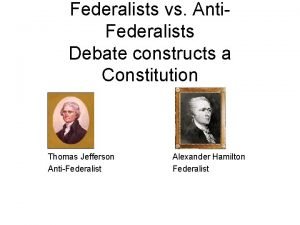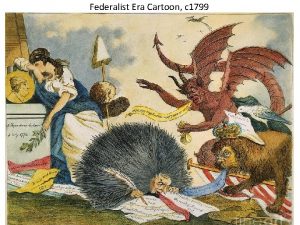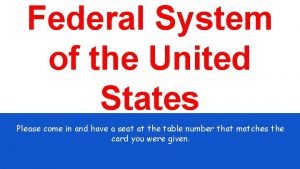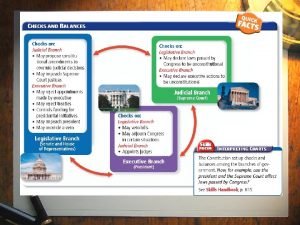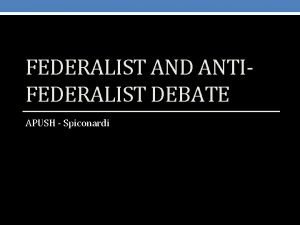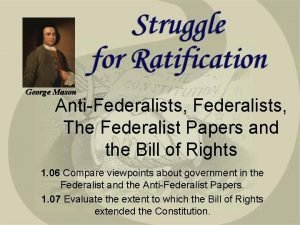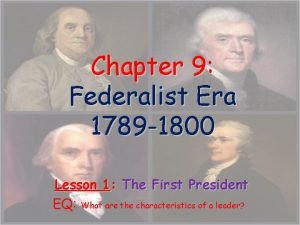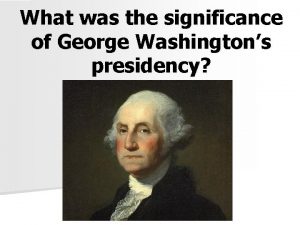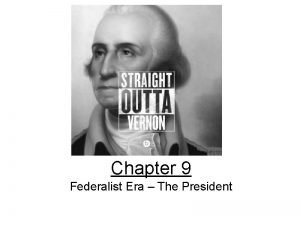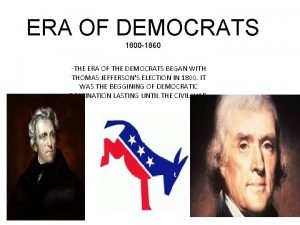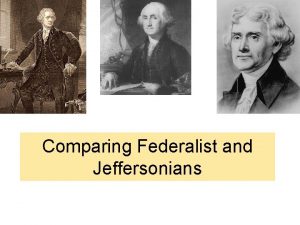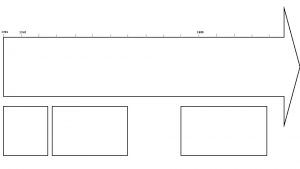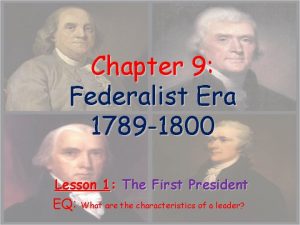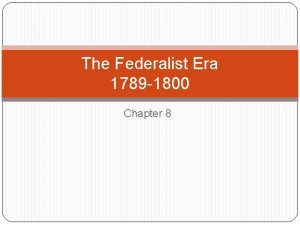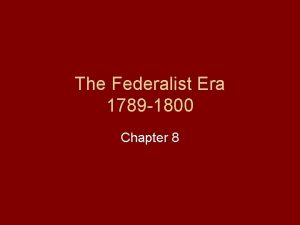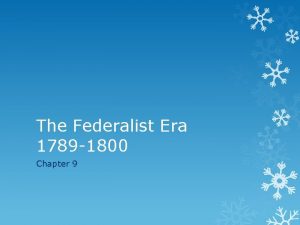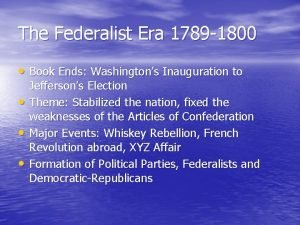Chapter 8 Notes The Federalist Era 1789 1800










- Slides: 10

Chapter 8 Notes The Federalist Era 1789 -1800

The First President Washington - 1789 1) John Adams – vice-president 2) Set up court system & added Bill of Rights A. The First Congress 1) Set up 3 Depts. In Executive Branch * State Dept. – Thomas Jefferson * Dept. of Treasury – Alexander Hamilton * Dept. of War – Henry Knox B. Judiciary Act of 1789: 1) Established the Supreme Court 2) Federal Court system, but allowed each state to create laws as well * Supreme Court could overrule state laws (final authority)

Bill of Rights Alexander Hamilton C. The Bill of Rights – 1 st 10 Amendments (additions) 1) Limits the powers of government 2) Americans feared strong central govt. 3) Protects rights of individuals (speech, crimes, etc. ) The New Country’s Economy A. Hamilton’s Plan 1) Needed to find a way to strengthen our nation & improve our financial reputation at the same time 2) Decided govt. should pay back all money owed to states 3) Felt this would give states a strong interest in the success of national govt. B. Opposition to the Plan 1) Congress agreed to pay other nations but not states

C. Compromise Gives a Capital 1) Hamilton got southern states to support his plan. 2) In return, National Capital was moved to the south 3) Between Virginia & Maryland D. Fight Over National Bank 1) Would be owned by private investors & national govt. 2) Some believed would only benefit the wealthy 3) Washington approved national bank. E. Tariffs & Taxes 1) Hamilton also had congress approve a variety of taxes * whiskey, * Imports, etc. 2) This created money to pay back national debt 3) Jefferson feared govt. might become too powerful

Early Challenges The Whiskey Rebellion & the West A. The Whiskey Rebellion 1) Farmers protested tax with violence 2) Washington crushed the rebellion 3) Sent the message that govt. would use force to maintain social order B. Struggle Over the West 1) Disputes with Native Americans for land west of the Appalachian Mtns. led to two wars 2) After the two wars, Native Am. surrendered most of their land in present day Ohio

Jay’s Treaty – Strengthened Relations With Great Britain Problems with Europe A. Washington Proclaims Neutrality 1) Jay’s Treaty – British agreed to withdraw from American soil B. Treaty with Spain 1) Pinckney’s Treaty – gave Americans free navigation of the Mississippi River & right to trade at New Orleans C. Washington’s Farewell 1) Didn’t run for a 3 rd term 2) Influenced foreign policy for more than 100 years

The First Political Parties Opposing Views A. Political Parties Emerge 1) By mid-1790’s, two parties form 2) Federalists – supported strong federal govt. * Admired the British govt. * Favored banking & shipping interests * Most support came from northeast 3) Republicans – wanted limited govt. power * Supported French govt. * Favored small farmers & urban workers * Most support came from south B. Views of the Constitution 1) Federalists – believed constitution gave the govt. “implied powers” 2) Republicans – believed govt. should have “strict interpretation” of the constitution

C. The People’s Role 1) Federalists believed in representative govt. (elected officials rule in name of the people) 2) Believed that only honest, educated men with property should lead our govt. 3) Republicans – Feared strong central govt. 4) Felt it would be more safe if “ordinary” people participated D. The Election of 1796 1) First election with rival parties 2) Federalist- former V. P. John Adams 3) Republicans – Thomas Jefferson 4) Adams – 71 votes, Jefferson 68 votes * Person with most votes – Pres. * Second most votes – V. P. *** Had a Fed. Pres. & a Rep. V. P

President John Adams A. The XYZ Affair 1) France seized American ships 2) France sent three agents (referred to as X Y & Z) to ask for a bribe. - Refused by America and prepared for war B. Alien & Sedition Acts 1) As public anger rose toward France, many questioned loyalty of immigrants. 2) Federalist implemented strict laws to protect national security. * Alien Act – allowed Pres. to imprison “aliens” (immigrants) * Sedition Act – crime to speak negatively of govt.

Jefferson – wrote Virginia Resolution Madison – wrote Kentucky Resolution C. Domestic & Foreign Affairs 1) Virginia & Kentucky Resolutions – basically said Alien& Sedition Acts violated the constitution a) Argued for States Rights b) Still controversial 2) In 1800 – America signed peace treaty with France 3) This treaty hurt Adams chance for re-election opening the door for Jefferson & the Republicans
 Federalists and anti-federalists
Federalists and anti-federalists What so
What so Federalist vs anti federalist political cartoon
Federalist vs anti federalist political cartoon Are you a federalist or anti federalist quiz
Are you a federalist or anti federalist quiz Federalists vs anti federalists apush
Federalists vs anti federalists apush George mason quotes anti federalist
George mason quotes anti federalist Lesson quiz 9-1 the federalist era answer key
Lesson quiz 9-1 the federalist era answer key Lesson quiz 9-1 the federalist era
Lesson quiz 9-1 the federalist era Chapter 9 lesson 2 early challenges
Chapter 9 lesson 2 early challenges The federalist era lesson 3
The federalist era lesson 3 What era was the 1800
What era was the 1800
